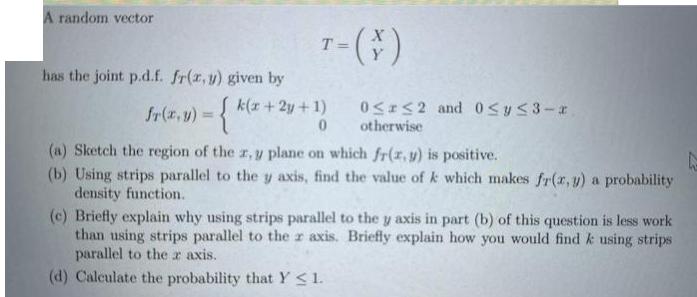Question
A random vector has the joint p.d.f. fr(x, y) given by T-(*) fr(x,y) = { k(x + 2y +1) 0 2 and 0y3-r otherwise

A random vector has the joint p.d.f. fr(x, y) given by T-(*) fr(x,y) = { k(x + 2y +1) 0 2 and 0y3-r otherwise (a) Sketch the region of the z, y plane on which fr(x,y) is positive. (b) Using strips parallel to the y axis, find the value of k which makes fr(x, y) a probability density function. (c) Briefly explain why using strips parallel to the y axis in part (b) of this question is less work than using strips parallel to the r axis. Briefly explain how you would find k using strips parallel to the r axis. (d) Calculate the probability that Y 1. L
Step by Step Solution
There are 3 Steps involved in it
Step: 1
Lets tackle each part of the question one at a time a Sketch the region of the x y plane on which fXYxy is positive For fx y to be positive we need bo...
Get Instant Access to Expert-Tailored Solutions
See step-by-step solutions with expert insights and AI powered tools for academic success
Step: 2

Step: 3

Ace Your Homework with AI
Get the answers you need in no time with our AI-driven, step-by-step assistance
Get StartedRecommended Textbook for
A First Course In Probability
Authors: Sheldon Ross
9th Edition
978-9332519077, 9332519072
Students also viewed these Mathematics questions
Question
Answered: 1 week ago
Question
Answered: 1 week ago
Question
Answered: 1 week ago
Question
Answered: 1 week ago
Question
Answered: 1 week ago
Question
Answered: 1 week ago
Question
Answered: 1 week ago
Question
Answered: 1 week ago
Question
Answered: 1 week ago
Question
Answered: 1 week ago
Question
Answered: 1 week ago
Question
Answered: 1 week ago
Question
Answered: 1 week ago
Question
Answered: 1 week ago
Question
Answered: 1 week ago
Question
Answered: 1 week ago
Question
Answered: 1 week ago
Question
Answered: 1 week ago
Question
Answered: 1 week ago
Question
Answered: 1 week ago
Question
Answered: 1 week ago
Question
Answered: 1 week ago
Question
Answered: 1 week ago
Question
Answered: 1 week ago
View Answer in SolutionInn App



